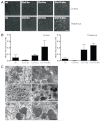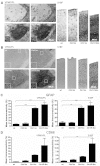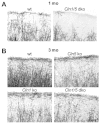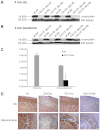Exacerbated neuronal ceroid lipofuscinosis phenotype in Cln1/5 double-knockout mice
- PMID: 23065637
- PMCID: PMC3597017
- DOI: 10.1242/dmm.010140
Exacerbated neuronal ceroid lipofuscinosis phenotype in Cln1/5 double-knockout mice
Abstract
Both CLN1 and CLN5 deficiencies lead to severe neurodegenerative diseases of childhood, known as neuronal ceroid lipofuscinoses (NCLs). The broadly similar phenotypes of NCL mouse models, and the potential for interactions between NCL proteins, raise the possibility of shared or convergent disease mechanisms. To begin addressing these issues, we have developed a new mouse model lacking both Cln1 and Cln5 genes. These double-knockout (Cln1/5 dko) mice were fertile, showing a slight decrease in expected Mendelian breeding ratios, as well as impaired embryoid body formation by induced pluripotent stem cells derived from Cln1/5 dko fibroblasts. Typical disease manifestations of the NCLs, i.e. seizures and motor dysfunction, were detected at the age of 3 months, earlier than in either single knockout mouse. Pathological analyses revealed a similar exacerbation and earlier onset of disease in Cln1/5 dko mice, which exhibited a pronounced accumulation of autofluorescent storage material. Cortical demyelination and more pronounced glial activation in cortical and thalamic regions was followed by cortical neuron loss. Alterations in lipid metabolism in Cln1/5 dko showed a specific increase in plasma phospholipid transfer protein (PLTP) activity. Finally, gene expression profiling of Cln1/5 dko cortex revealed defects in myelination and immune response pathways, with a prominent downregulation of α-synuclein in Cln1/5 dko mouse brains. The simultaneous loss of both Cln1 and Cln5 genes might enhance the typical pathological phenotypes of these mice by disrupting or downregulating shared or convergent pathogenic pathways, which could potentially include interactions of CLN1 and CLN5.
Figures







Similar articles
-
Brain gene expression profiles of Cln1 and Cln5 deficient mice unravels common molecular pathways underlying neuronal degeneration in NCL diseases.BMC Genomics. 2008 Mar 28;9:146. doi: 10.1186/1471-2164-9-146. BMC Genomics. 2008. PMID: 18371231 Free PMC article.
-
Proteomic Profiling in the Brain of CLN1 Disease Model Reveals Affected Functional Modules.Neuromolecular Med. 2016 Mar;18(1):109-33. doi: 10.1007/s12017-015-8382-6. Epub 2015 Dec 26. Neuromolecular Med. 2016. PMID: 26707855
-
Novel interactions of CLN5 support molecular networking between Neuronal Ceroid Lipofuscinosis proteins.BMC Cell Biol. 2009 Nov 26;10:83. doi: 10.1186/1471-2121-10-83. BMC Cell Biol. 2009. PMID: 19941651 Free PMC article.
-
Cellular pathology and pathogenic aspects of neuronal ceroid lipofuscinoses.Adv Genet. 2001;45:35-68. doi: 10.1016/s0065-2660(01)45003-6. Adv Genet. 2001. PMID: 11332776 Review.
-
Progress towards understanding disease mechanisms in small vertebrate models of neuronal ceroid lipofuscinosis.Biochim Biophys Acta. 2006 Oct;1762(10):873-89. doi: 10.1016/j.bbadis.2006.08.002. Epub 2006 Aug 10. Biochim Biophys Acta. 2006. PMID: 17023146 Review.
Cited by
-
Autophagy-lysosome pathway alterations and alpha-synuclein up-regulation in the subtype of neuronal ceroid lipofuscinosis, CLN5 disease.Sci Rep. 2019 Jan 17;9(1):151. doi: 10.1038/s41598-018-36379-z. Sci Rep. 2019. PMID: 30655561 Free PMC article.
-
Proteomic and functional analyses in disease models reveal CLN5 protein involvement in mitochondrial dysfunction.Cell Death Discov. 2020 Mar 30;6:18. doi: 10.1038/s41420-020-0250-y. eCollection 2020. Cell Death Discov. 2020. PMID: 32257390 Free PMC article.
-
Cellular models of Batten disease.Biochim Biophys Acta Mol Basis Dis. 2020 Sep 1;1866(9):165559. doi: 10.1016/j.bbadis.2019.165559. Epub 2019 Oct 23. Biochim Biophys Acta Mol Basis Dis. 2020. PMID: 31655107 Free PMC article. Review.
-
A murine model of variant late infantile ceroid lipofuscinosis recapitulates behavioral and pathological phenotypes of human disease.PLoS One. 2013 Nov 1;8(11):e78694. doi: 10.1371/journal.pone.0078694. eCollection 2013. PLoS One. 2013. PMID: 24223841 Free PMC article.
-
Next-Generation Sequencing Analysis Reveals Novel Pathogenic Variants in Four Chinese Siblings With Late-Infantile Neuronal Ceroid Lipofuscinosis.Front Genet. 2019 Apr 25;10:370. doi: 10.3389/fgene.2019.00370. eCollection 2019. Front Genet. 2019. PMID: 31105743 Free PMC article.
References
-
- Abeliovich A., Schmitz Y., Fariñas I., Choi-Lundberg D., Ho W. H., Castillo P. E., Shinsky N., Verdugo J. M., Armanini M., Ryan A., et al. (2000). Mice lacking alpha-synuclein display functional deficits in the nigrostriatal dopamine system. Neuron 25, 239-252 - PubMed
-
- Ahtiainen L., Kolikova J., Mutka A. L., Luiro K., Gentile M., Ikonen E., Khiroug L., Jalanko A., Kopra O. (2007). Palmitoyl protein thioesterase 1 (Ppt1)-deficient mouse neurons show alterations in cholesterol metabolism and calcium homeostasis prior to synaptic dysfunction. Neurobiol. Dis. 28, 52-64 - PubMed
-
- Bible E., Gupta P., Hofmann S. L., Cooper J. D. (2004). Regional and cellular neuropathology in the palmitoyl protein thioesterase-1 null mutant mouse model of infantile neuronal ceroid lipofuscinosis. Neurobiol. Dis. 16, 346-359 - PubMed
-
- Camp L. A., Hofmann S. L. (1993). Purification and properties of a palmitoyl-protein thioesterase that cleaves palmitate from H-Ras. J. Biol. Chem. 268, 22566-22574 - PubMed
Publication types
MeSH terms
Substances
LinkOut - more resources
Full Text Sources
Molecular Biology Databases
Research Materials
Miscellaneous

